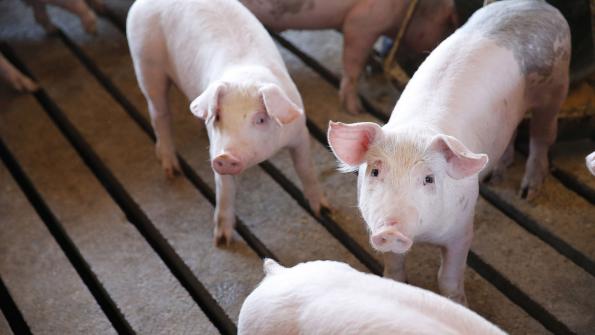As the heavier pigs started to slow down, this showed in daily gain dropping off and feed/gain increasing but that is where the response from the increased vitamin E levels was the greatest.

More aggressive vitamin E supplementation above the National Resource Council requirement estimate may have more benefit than risk in pig diets, according to a new University of Kentucky study.
During the recent DSM Pork NEXUS meeting, professor Merlin Lindemann was able to share some preliminary results from his research with graduate student Ding Wang. Funded by the National Pork Board, the Fats and Proteins Research Foundation and DSM, the research centered around the “Effects of vitamin E sources and level on growth performance and health of pigs from 60 to 330 pounds.”
The NRC requirement for vitamin E level for all weights of growing-finishing pigs has been 11 international units per kilogram of diet since 1988. In this set of experiments, the researchers set the bar higher.
“We’ve got responses in performance to higher levels of vitamin E, but I think again its context sensitive, how did we set the study up so that something else hopefully was not limiting,” Lindemann says. “We made sure that other vitamins were supplemented at a higher amount and were not potentially limiting the response to the vitamin E.”
In Experiment I, the effects of two Vitamin E levels (11 and 200 ppm, α-tocopherol) were evaluated on growth performance and health in conjunction with four added fat sources (none, coconut oil, tallow or distillers corn oil). The study was made up of 64 individually housed pigs (32 barrows, 32 gilts) each with an initial body weight of around 60 pounds. The pigs were fed five diet phases from 60 to 330 pounds.
Lindemann notes that since the NRC amino acid requirement estimates only go up to 300 pounds, and this study went up to 330 pounds, the researchers turned to industry sources for suggestions for the heavy weight pigs and decided to set the lysine level for the last phase at 0.54%.
Fat treatments included corn-starch, tallow, corn oil and coconut oil. Vitamin E supplementation was at 11 and 200 IU/kg.
No interactions between dietary fat sources and VE supplementation were observed. Increasing dietary VE level from 11 to 200 IU/kg increased the tocopherol concentration significantly in both liver (4.73 vs. 21.06 ppm wet liver) and loin muscle (1.25 vs. 2.67 ppm wet muscle).
Pigs from the coconut oil group had lower activity of an antioxidant enzyme in the liver than the other treatments. Pigs from the coconut oil group had the highest total saturated fatty acid content, and the lowest total polyunsaturated fatty acid content and iodine value in the backfat; while pigs from the corn oil group had the lowest total saturated fatty acid content and the highest total polyunsaturated content and iodine value. Pigs from the tallow group had the highest total monounsaturated fatty acid content and an intermediate iodine value in the backfat.
Lindemann says under conditions of this study, both dietary fat source and VE supplementation affected the response measures.
Looking at vitamin E concentration in plasma, Lindemann says they saw significant effects with the 200-ppm level, reaching up to 5.20 units by the time the pigs weighed 275 pounds.
“If you want to optimize immune response, a number of people talk about having three units of vitamin E in the plasma, we got it,” Lindemann says. “This was 200 ppm of vitamin E we supplemented with, which is high, but you can get it there, you can get it higher in the plasma.”
Looking at growth rate, Lindemann says it’s important to remember with nutrition, that both toxicity or recovery from a deficiency is going to be a time-dose relationship and it may take awhile for the response to settle in. As the heavier pigs started to slow down, this showed in daily gain dropping off and feed/gain increasing but that is where the response from the increased vitamin E levels was the greatest.
In Experiment II, the objective was to assess the contribution of two fat sources and six vitamin E supplementation treatments on growth performance and antioxidant status of pigs at heavy slaughter weight (again, about 330 pounds). A total of 72 individually-fed pigs (36 barrows, 36 gilts; 63 pounds) were randomly assigned to the 12 dietary treatments. Fat treatments were tallow and corn-oil. The vitamin E treatment included four levels of α-tocopheryl-acetate (ATA; 11, 40, 100 and 200 ppm) and two levels of mixed tocopherol (primarily γ-tocopherol; 40 and 100 ppm).
While no significant interaction between fat sources and ATA was detected on the growth performance of each phase and liver antioxidant status at slaughter and no significant effects of dietary fat sources and VE isoforms were detected, increasing dietary ATA linearly improved daily gain and daily feed intake during Phase 1 (60-110 pounds, P < 0.05), Phase 3 (165-220 pounds, P < 0.05), and overall (60-330 pounds, P < 0.05).
Increasing dietary ATA quadratically increased liver antioxidant enzyme activity, and quadratically decreased the levels of an oxidative product in the liver. Beneficial effects of dietary VE supplementation were thus observed on both growth performance and antioxidant status of pigs under conditions of this study, but Lindemann reiterates it’s a time/dose relationship.
“If it’s a true response, it builds across time,” Lindemann says.
Lindemann says while the research is not exhaustive, and the results may have been affected by the experimental conditions more than has been assumed to date, vitamins are critical.
“The cost for many vitamins is low,” Lindemann says. “The risk to benefit evaluations from robust models would argue for more aggressive supplementation above ‘requirement’ estimates.”
About the Author(s)
You May Also Like





